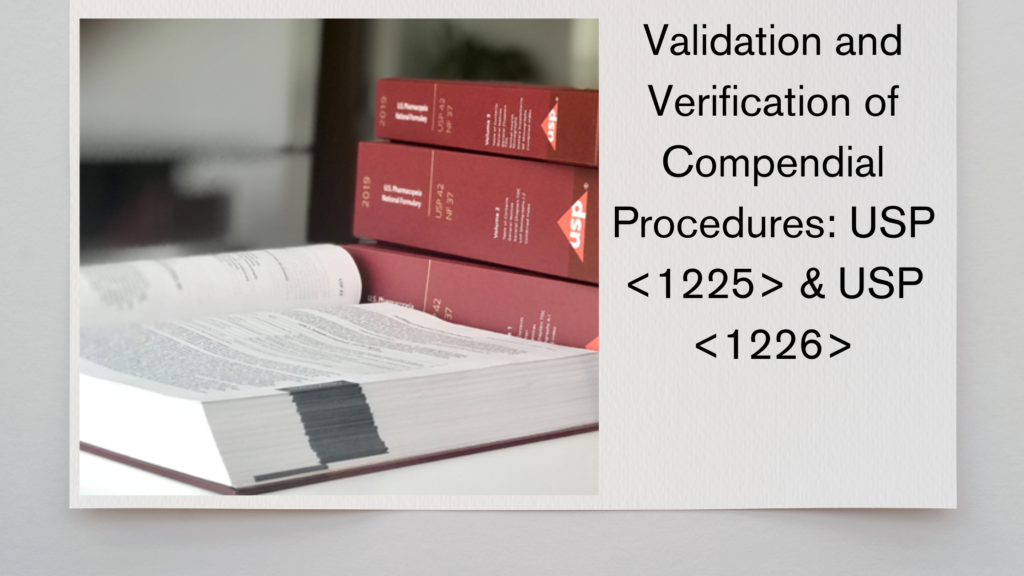
In the pharmaceutical industry, it is critical to ensure that testing methods are accurate, reliable, and suitable for their intended purpose. USP <1225> and USP <1226> provide guidelines to achieve this by focusing on the validation and verification of analytical procedures.
- USP <1225>: Focuses on the validation of analytical methods, ensuring that these methods meet established performance standards for accuracy, precision, specificity, and other essential criteria.
- USP <1226>: Provides guidelines for verification, which ensures that a validated method performs as expected when applied in a specific lab or setting for the first time.
Key Parameters for Validation
Below is a table summarizing the parameters required for different types of analytical procedures under validation (USP <1225>).
| Parameter | Assays & Quantitative Tests | Impurity Tests | Performance Tests | Identification Tests |
| Accuracy | Yes | Yes | Optional | No |
| Precision | Yes | Yes | Optional | No |
| Specificity | Yes | Yes | Optional | Yes |
| Limit of Detection | No | Yes | No | Optional |
| Limit of Quantitation | No | Yes | No | No |
| Linearity | Yes | Yes | Optional | Optional |
| Range | Yes | Yes | Optional | Optional |
| Robustness | Optional | Optional | Optional | Optional |
| System Suitability | Yes | Yes | Yes | Yes |
Explanation of Key Parameters for Validation
- Accuracy: Measures the closeness of test results to the true value, ensuring the correct concentration or amount of an analyte is determined.
- Precision: Reflects the consistency of results across multiple trials, regardless of the operator or timing, confirming the method’s reproducibility.
- Specificity: Ensures the method measures only the target analyte, without interference from other components such as excipients.
- Limit of Detection (LOD): Identifies the smallest detectable amount of an analyte, crucial for detecting impurities at trace levels.
- Limit of Quantitation (LOQ): Represents the lowest concentration measurable with accuracy and precision, essential for quantifying small quantities of impurities.
- Linearity: Verifies that results are proportional to analyte concentration within a specified range.
- Range: Refers to the interval between upper and lower concentrations where the method remains reliable and specific.
- Robustness: Assesses reliability under minor variations in conditions, such as temperature or pH changes.
- System Suitability: Confirms that equipment is functioning properly before testing, ensuring factors like peak resolution and retention time are within acceptable limits.
Categories of Analytical Procedures under USP <1225>
USP <1225> classifies analytical procedures into four main categories:
- Category I: Assays to quantify the active pharmaceutical ingredient (API) or other major components.
- Category II: Tests for impurities, including qualitative and quantitative analysis.
- Category III: Performance tests, such as dissolution and drug release studies.
- Category IV: Identification tests to confirm the presence of specific compounds.
Documentation Requirements for Validation
- Validation Protocols: Define the purpose, scope, and acceptance criteria.
- Raw Data: Includes chromatograms, calibration curves, and detailed test results.
- Validation Reports: Summarize validation findings and confirm method suitability.
- Deviation Reports: Document any deviations and corrective actions to ensure traceability.
What is Verification? (USP <1226>)
Verification ensures that a validated compendial method performs effectively when applied in a specific laboratory setting or with a specific product for the first time. Unlike validation, which broadly establishes a method’s performance, verification confirms its effectiveness under actual conditions of use.
When is Verification Needed?
Verification is typically required in the following cases:
- New Laboratory Setting: When a compendial method is used for the first time in a different laboratory.
- Changes in Product Matrix: When the product contains new excipients or is supplied by different vendors.
- Routine Quality Control: To confirm that the method remains suitable for regular manufacturing and testing.
Performance Characteristics for Verification
| Parameter | Requirement for Verification |
| Specificity | Ensures detection of only the target analyte without interference. |
| Precision | Confirms consistent results in quantitative procedures. |
| Limit of Detection | Necessary for impurity testing to ensure trace contaminants are detectable. |
| Limit of Quantitation | Confirms small quantities can be measured accurately for impurities. |
| System Suitability | Essential for verifying equipment function before analysis. |
| Matrix Effect | Ensures analyte recovery from complex formulations, especially with new excipients. |
Examples of When Verification is Essential
- Drug Products with Different Excipients: Verifies that the presence of new excipients does not interfere with the test results.
- Impurities from Different Suppliers: Confirms the method’s ability to detect impurities that may arise from new raw material sources.
- Containers with Extractables and Leachables: Ensures that container materials do not impact the analyte recovery, providing accurate results.
Differences Between Validation (USP <1225>) and Verification (USP <1226>)
| Aspect | USP <1225> (Validation) | USP <1226> (Verification) |
| Purpose | Develops and validates new methods. | Confirms suitability of existing methods. |
| Scope | Comprehensive assessment. | Focuses on key performance characteristics. |
| When Required | For new or modified methods. | For first-time use in a specific setting. |
| Parameters Assessed | All relevant performance parameters. | Selected parameters based on use case. |
| Documentation | Extensive validation protocols and reports. | Verification reports with relevant data. |
Watch and understand it on YouTube as well.

